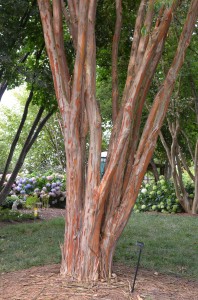If you garden in USDA zone 6, certain crape myrtle cultivars are rated as reliably winter hardy perennials. Most dependable are the U.S. National Arboretum cultivars released starting in the 1980’s to date. Each one is named for an Indian tribe. Most of the National Arboretum cultivars are selected for cold hardiness as well as for disease and insect resistance.
Among the cold hardiest (zone 6-b) are the popular ‘ Natchez’ (26-28 feet/ white flowering tree form). This should be the first crape myrtle to trial in your landscape. Also worth trying are ‘Acoma’ (5-10 feet/white flowering), ‘Apalachee’ (11-16 feet/light lavender), ‘Hopi’ (8-10 feet/medium pink), ‘Sioux’ (10-16 feet/dark pink), ‘Tonto’ (8-10 feet/maroon red flowers), ‘Tuscarora’ (26 feet/dark pink), and ‘Pocomoke’ (3-5 feet/dark pink flowers).
Plant crape myrtles in well-drained soil and in full day sunlight. During the initial year of planting, water and mulch the crape myrtle when natural rainfall falls short. Fertilize with 10-10-10 fertilizer or equivalent following spring planting and repeat every spring hereafter.
Living in zone 6, expect that out of every three winters will kill crape myrtle(s) to the ground. To prevent winter injury, never prune a crape myrtle in the fall or early winter. The pruning cuts often do not heal over and the wood may be killed. Sudden spring cold snaps may also injure the growth buds. Wait until mid-spring to evaluate the harshness of the past winter before acting.
The rootsystem is very hardy and will push up new shoots in the spring. Crape myrtle blooms on new wood, and summer flowering is not lost. Yes, your winter injured crape myrtle may be smaller, but it often survives and flowers.


 Posted in
Posted in 
